Intel Core i7-10700 vs Core i7-10700K Review: Is 65W Comet Lake an Option?
by Dr. Ian Cutress on January 21, 2021 10:30 AM EST- Posted in
- CPUs
- Intel
- Core i7
- Z490
- 10th Gen Core
- Comet Lake
- i7-10700K
- i7-10700
CPU Tests: Rendering
Rendering tests, compared to others, are often a little more simple to digest and automate. All the tests put out some sort of score or time, usually in an obtainable way that makes it fairly easy to extract. These tests are some of the most strenuous in our list, due to the highly threaded nature of rendering and ray-tracing, and can draw a lot of power. If a system is not properly configured to deal with the thermal requirements of the processor, the rendering benchmarks is where it would show most easily as the frequency drops over a sustained period of time. Most benchmarks in this case are re-run several times, and the key to this is having an appropriate idle/wait time between benchmarks to allow for temperatures to normalize from the last test.
Blender 2.83 LTS: Link
One of the popular tools for rendering is Blender, with it being a public open source project that anyone in the animation industry can get involved in. This extends to conferences, use in films and VR, with a dedicated Blender Institute, and everything you might expect from a professional software package (except perhaps a professional grade support package). With it being open-source, studios can customize it in as many ways as they need to get the results they require. It ends up being a big optimization target for both Intel and AMD in this regard.
For benchmarking purposes, we fell back to one rendering a frame from a detailed project. Most reviews, as we have done in the past, focus on one of the classic Blender renders, known as BMW_27. It can take anywhere from a few minutes to almost an hour on a regular system. However now that Blender has moved onto a Long Term Support model (LTS) with the latest 2.83 release, we decided to go for something different.
We use this scene, called PartyTug at 6AM by Ian Hubert, which is the official image of Blender 2.83. It is 44.3 MB in size, and uses some of the more modern compute properties of Blender. As it is more complex than the BMW scene, but uses different aspects of the compute model, time to process is roughly similar to before. We loop the scene for at least 10 minutes, taking the average time of the completions taken. Blender offers a command-line tool for batch commands, and we redirect the output into a text file.

The 10700K takes a small lead.
Corona 1.3: Link
Corona is billed as a popular high-performance photorealistic rendering engine for 3ds Max, with development for Cinema 4D support as well. In order to promote the software, the developers produced a downloadable benchmark on the 1.3 version of the software, with a ray-traced scene involving a military vehicle and a lot of foliage. The software does multiple passes, calculating the scene, geometry, preconditioning and rendering, with performance measured in the time to finish the benchmark (the official metric used on their website) or in rays per second (the metric we use to offer a more linear scale).
The standard benchmark provided by Corona is interface driven: the scene is calculated and displayed in front of the user, with the ability to upload the result to their online database. We got in contact with the developers, who provided us with a non-interface version that allowed for command-line entry and retrieval of the results very easily. We loop around the benchmark five times, waiting 60 seconds between each, and taking an overall average. The time to run this benchmark can be around 10 minutes on a Core i9, up to over an hour on a quad-core 2014 AMD processor or dual-core Pentium.
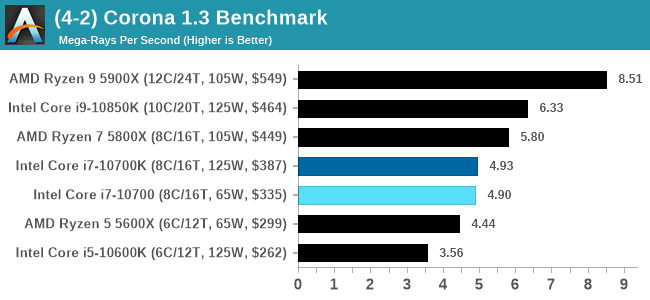
The 10700K takes a small lead.
Crysis CPU-Only Gameplay
One of the most oft used memes in computer gaming is ‘Can It Run Crysis?’. The original 2007 game, built in the Crytek engine by Crytek, was heralded as a computationally complex title for the hardware at the time and several years after, suggesting that a user needed graphics hardware from the future in order to run it. Fast forward over a decade, and the game runs fairly easily on modern GPUs.
But can we also apply the same concept to pure CPU rendering? Can a CPU, on its own, render Crysis? Since 64 core processors entered the market, one can dream. So we built a benchmark to see whether the hardware can.
For this test, we’re running Crysis’ own GPU benchmark, but in CPU render mode. This is a 2000 frame test, with medium and low settings.
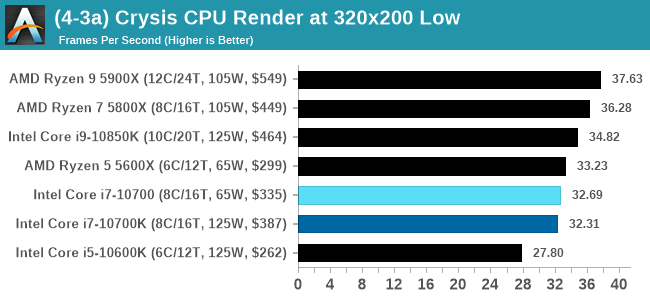
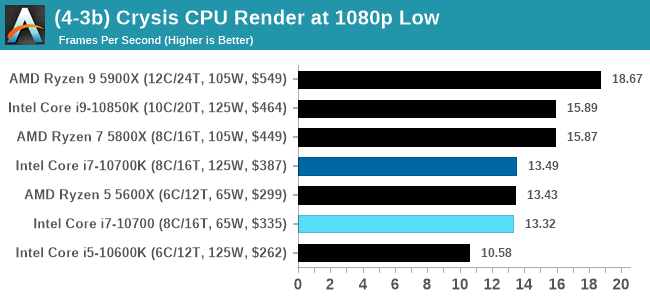
Almost playable.
POV-Ray 3.7.1: Link
A long time benchmark staple, POV-Ray is another rendering program that is well known to load up every single thread in a system, regardless of cache and memory levels. After a long period of POV-Ray 3.7 being the latest official release, when AMD launched Ryzen the POV-Ray codebase suddenly saw a range of activity from both AMD and Intel, knowing that the software (with the built-in benchmark) would be an optimization tool for the hardware.
We had to stick a flag in the sand when it came to selecting the version that was fair to both AMD and Intel, and still relevant to end-users. Version 3.7.1 fixes a significant bug in the early 2017 code that was advised against in both Intel and AMD manuals regarding to write-after-read, leading to a nice performance boost.
The benchmark can take over 20 minutes on a slow system with few cores, or around a minute or two on a fast system, or seconds with a dual high-core count EPYC. Because POV-Ray draws a large amount of power and current, it is important to make sure the cooling is sufficient here and the system stays in its high-power state. Using a motherboard with a poor power-delivery and low airflow could create an issue that won’t be obvious in some CPU positioning if the power limit only causes a 100 MHz drop as it changes P-states.

V-Ray: Link
We have a couple of renderers and ray tracers in our suite already, however V-Ray’s benchmark came through for a requested benchmark enough for us to roll it into our suite. Built by ChaosGroup, V-Ray is a 3D rendering package compatible with a number of popular commercial imaging applications, such as 3ds Max, Maya, Undreal, Cinema 4D, and Blender.
We run the standard standalone benchmark application, but in an automated fashion to pull out the result in the form of kilosamples/second. We run the test six times and take an average of the valid results.
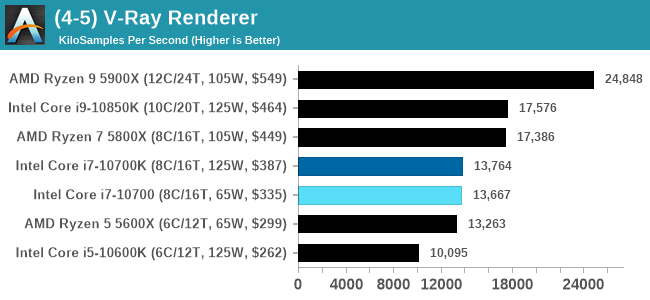
Cinebench R20: Link
Another common stable of a benchmark suite is Cinebench. Based on Cinema4D, Cinebench is a purpose built benchmark machine that renders a scene with both single and multi-threaded options. The scene is identical in both cases. The R20 version means that it targets Cinema 4D R20, a slightly older version of the software which is currently on version R21. Cinebench R20 was launched given that the R15 version had been out a long time, and despite the difference between the benchmark and the latest version of the software on which it is based, Cinebench results are often quoted a lot in marketing materials.
Results for Cinebench R20 are not comparable to R15 or older, because both the scene being used is different, but also the updates in the code bath. The results are output as a score from the software, which is directly proportional to the time taken. Using the benchmark flags for single CPU and multi-CPU workloads, we run the software from the command line which opens the test, runs it, and dumps the result into the console which is redirected to a text file. The test is repeated for a minimum of 10 minutes for both ST and MT, and then the runs averaged.

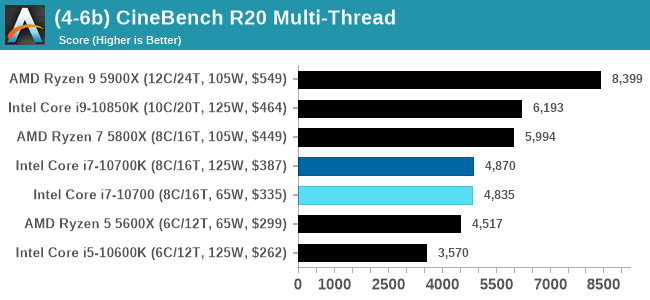
We are still in the process of rolling out CineBench R23 (you can see the results in our benchmark database here), but had not tested it on all the CPUs in this review at this time. It will be added to future reviews.




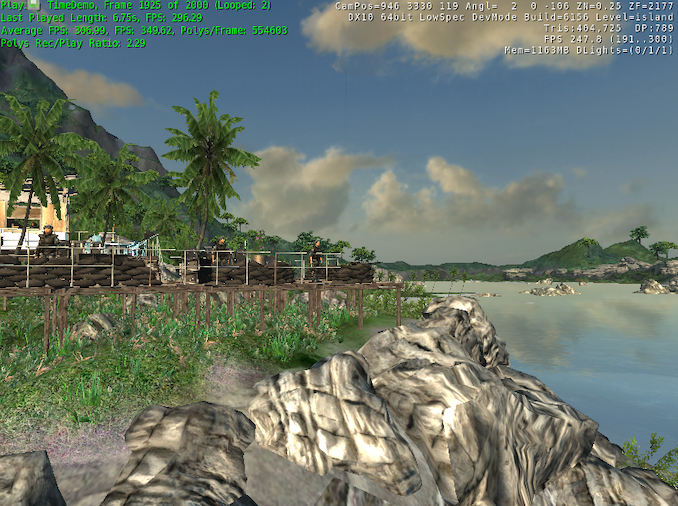











210 Comments
View All Comments
Oxford Guy - Sunday, January 24, 2021 - link
This site posted articles about overclocking that were done wildly, without true stability testing and with reckless amounts of voltage and you're going to now pretend that turning on XMP for RAM is some kind of terrible reckless matter?Oxford Guy - Sunday, January 24, 2021 - link
The thing is... if you wish to take a stand about JEDEC and company standards that's fine. Just don't post a lot of nonsensical reasons for it, like "Most users don't know how to plug in a computer so we're going to skip the plug for this review".Oxford Guy - Sunday, January 24, 2021 - link
Personally, here is all I'd say on the subject, were I to be taking your stand:'We use JEDEC standards for RAM speed because those are what AMD, Intel, and other CPU makers use to rate their chips. Anything beyond JEDEC is overclocking and is therefore running out of spec.
Although motherboard makers frequently choose to run CPUs out of spec, such as by boosting to the turbo speech and keeping it there indefinitely, and by including XMP profiles for RAM with lists of 'compatible' RAM running beyond JEDEC, it is our belief that the best place for a CPU's maximum supported RAM speech spec to come from is from the CPU's creator.
If anyone is unhappy about this standard we suggest lobbying the CPU makers to be more aggressive about officially supporting faster RAM speeds, such as by formally adopting XMP as a spec that is considered to be within spec for a CPU.
To compliment the goal of our JEDEC stance, are going to only create reviews using motherboards that fully comply with the turbo spec of vendors and/or disable all attempts by board makers to game that spec. If a board cannot be brought into full compliance we will refuse to post a review of it and any mention of it with the possible exception of a list of boards that run out of spec, are non-compliant.'
Qasar - Sunday, January 24, 2021 - link
Oxford Guy you seem to be quite unhappy about this review, and by other posts, the site as well, so if this site is so bad, WHY do you keep coming here ?Spunjji - Monday, January 25, 2021 - link
He's certainly not his own best advocate in that regard.I'd always defend someone's right to criticise aspects of something they otherwise like, but sometimes it goes a bit far.
Oxford Guy - Monday, January 25, 2021 - link
'but sometimes it goes a bit far.'Extreme vagueness + ad hom = extra fail.
Spunjji - Wednesday, January 27, 2021 - link
@Oxford Guy - 🙄1) That wasn't an ad-hominem - if you're going to do the "master debater" thing, at least learn to distinguish between commentary on the person and their argument.
2) Re: "extreme vagueness" - that was my personal opinion stated as a colloquialism. I don't owe anyone an annotated list of every comment you made, metric measurements of precisely how far they went, an objectively-defined scale of how far is too far, and a peer-reviewed thesis on the precise moment at which you exceeded that point.
Oxford Guy - Monday, January 25, 2021 - link
Ad hom... how unsurprising.To answer your question — This site is not bad. This site is good because people are able to give their honest opinions instead of living in a disgusting echo chamber like on ArsTechnica or Slashdot.
Perhaps that's where YOU should go instead.
Qasar - Tuesday, January 26, 2021 - link
why would i go there ? this site is top notch when it comes to reviews and comp hardware news. "This site is good because people are able to give their honest opinions " yes, but sometimes, some go to far with the whining and complaining :-)trenzterra - Friday, January 22, 2021 - link
Would be good if we could have some temperatures to compare as well. I used to buy the mid-end non-K Intel CPUs since I don't overclock but I always ended up with temperatures about 10 degrees higher than what most people report. With my latest build (ok, not that new now that it's actually a i5-6600k), I went for the K variant and temperatures are much better and in line with what most users report.